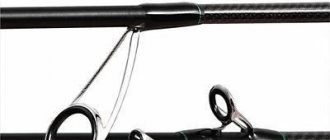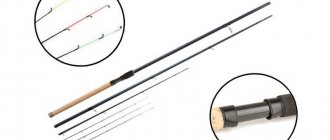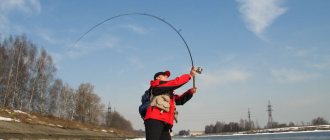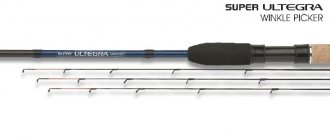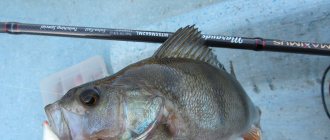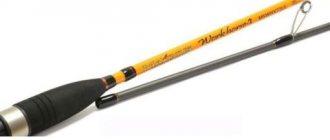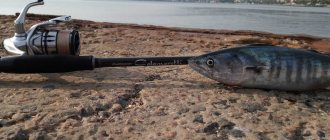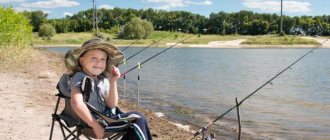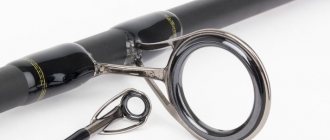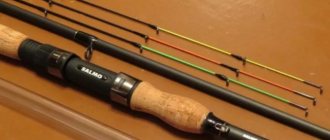Microjig. Difference between Solid and Tubular spinning rod tips using simple examples
Any microjig spinning rod is a rather delicate tackle and requires a subtle approach to its selection.
This approach consists of choosing the type of rod tip, which can be hollow and be a single part of the form (Tubular Tip) or glued into the form, while being very flexible and monolithic, i.e. without voids inside (Solid Tip). Design differences also dictate different approaches to fishing itself with these two very different types of spinning gear. It is important to understand the very physics of how both work. Then you can count not only on success, which goes without saying, but also on the pleasure of using this or that equipment. And they are very different.
Fundamental differences
- The hollow tip (Tubular)
shows sensitivity “in the hand”. You will more clearly feel and understand the weight falling to the bottom. However, the wiring is more difficult to trace visually, i.e. along the tip of the spinning rod. - The monolithic tip (Solid)
allows you to visually monitor what is happening with the bait of the smallest weights along the tip, but it will be worse to knock on your hand. Monolithic tips are usually made of fiberglass - it is more flexible than carbon fiber.
Let's look at it step by step
To understand the difference, you need to try similar rods in practice. This is not always possible, because... microjig rods are quite expensive, you won’t be able to try one after another, and therefore I will offer you a little experience of what will happen in different cases with different weights of bait on two, again, different microjig spinning rods.
So, let’s say you have two medium-budget spinning rods with 0.5-6 grams of dough and the same length. One has a Solid tip, the other has a Tubular tip. Fishing takes place on a shallow river, typical for microjig, with minimal current and a large number of reaches.
Changing the Cheburashkas by weight, the same for both spinning rods, we will simulate the same typical situations. And we will be able to create a very clear picture of the interaction of tubular and solid spinning rods with identical baits of different weights.
Weight 1.5 grams
The solid will show a fall along the tip on almost any ground, along the fishing line - especially since it won’t hit your hand. The tubular will hardly show at the tip, but along the fishing line it’s fine, and it won’t hit your hand yet.
Weight 2 grams
The picture is still the same, only the tubular will show a little better at the tip as the weight increases. The solid will play with all its might with the tip, the tubular, if the bottom is hard, will only begin to play normally with the tip.
Weight 2.5 grams
Solid plays with the tip, the tubular knocks weakly and every now and then.
Weight 3 grams
The tubular begins to show its capabilities - it knocks on almost any bottom, and everything is visible at the tip just like on a solid at 2 grams. The solid on a hard bottom at 3 grams begins to knock slightly and still shows the tip perfectly on any bottom.
Weight 4 grams
The solid starts to knock well on medium and hard bottoms, but there’s nothing to say about the tip - it does its job with five plus. The tubule is knocking, everything is fine.
Weight 5 grams
The top of the solid moves back and forth very much, but everything is fine with it - it can bend like crazy! It knocks, of course, but it feels like it’s on the edge. Then it may start to fail. The tubular can easily handle 5 grams and will handle the upper limit of 6 grams.
conclusions
You shouldn’t overload the solid, it’s better to underload it a little. The flexible and very sensitive tip makes adjustments. It is possible to overload the tube by one gram, but it is not necessary, it will fail.
Thus, now you can easily understand the very meaning of how a microjig spinning rod works with one or another type of tip and choose the one that is best suited for your tasks.
Obviously, a spinning rod with a Solid tip is more suitable for delicate fishing with the smallest weights and requires visual attention to control the retrieve and bite.
A spinning rod with a Tubular tip is somewhat rougher, but it allows you to fish in more extreme conditions than a spinning rod with a solid tip - it is not so afraid of the current, which can easily “turn off” the delicate and flexible solid tip from working.
Tubular or solid spinning - About fishing
Domestic fishermen have become interested in a new direction in spinning fishing called rock fishing.
This method allows you to enjoy fishing both in coastal sea areas and in freshwater bodies of water. To master a new method of fishing, you first need to purchase a spinning rod for rock fishing.
It has a number of distinctive technical characteristics. Choosing a fishing rod will be a little easier if you understand exactly what rock fishing is.
Rock phishing capabilities
Japanese fishermen have learned to successfully use microjig fishing in surf conditions. They used ultralight spinning rods along with small spoons, wobblers and edible rubber, catching small bottom dwellers. These representatives of the marine ichthyofauna spend most of their lives among coastal rocks and stones.
The Japanese are known throughout the world for their commitment to excellence. Based on the demands of anglers, manufacturers have made a series of special spinning rods that organically combine rigidity with the highest sensitivity.
At international competitions, domestic athletes appreciated the benefits of rock fishing. They brought home with them sea tackle and bait. It turned out that local freshwater fish can also be caught using the new method.
Gradually, rod manufacturers began to make changes to purely rock fishing “sticks”, developing spinning rods for fishing bass or trout.
As for possible trophies, fishing is fraught with many surprises.
So in the coastal waters of the Black Sea you can catch all kinds of gobies or sea bass; on the coasts of other seas you can catch cod or mullet.
The species most commonly encountered by Japanese anglers are ayu and mebaru. And in freshwater bodies of water, perch and pike will bite well.
Requirements for the rod
A good spinning rod for sea fishing from the shore should have a set of specific properties. Most often, fishing takes place on pebble beaches, rocky and rocky areas with a depth of up to 5 m.
- For such fishing conditions, a light rod with a length of 1.8-2.7 m is suitable. Most anglers consider the optimal length range to be 2.2-2.6 m.
- The test load is selected based on the weight of the baits used. In shallow water areas with weak rolling waves, you can fish with microjig baits weighing up to 3 g. If a strong current is complemented by great depth at the fishing point, then baits weighing up to 8 g are used.
When choosing a rod structure, the Japanese adhere to the following concept. There are two directions, both tied to a specific species of marine fish.
- The MEBARU series is designed for bottom fishing of small fish of the same name. Rods of this class have a soft tip, which allows you to track every bite and every touch of the bottom. The blank of the spinning rod has a fast action, and the butt is made powerful and rigid.
- The Aji rod series has been created for fishing small coastal mackerel. This predator is caught by jerking, using wobblers and silicone baits. Spinning rods are made with a hard tip, which allows for better animation of artificial fish. However, when posting, the entire form is included in the work, although it is considered fast.
The tackle is equipped with an ordinary marine “meat grinder” and a thin braided cord.
Recommendation!
If fishing takes place among rocks, then it is better to install a fluorocarbon leash. This material is highly wear resistant.
Features of spinning rods for rock fishing
When choosing a spinning rod for rock fishing, you should know about some of the features of these rods.
First of all, it is worth noting that real rock fishing “sticks” are made by famous Japanese brands. Such a fishing rod will bring a lot of positive emotions from fishing, but the price of a branded spinning rod is quite high. Today, budget options are appearing from other well-known manufacturers, so you can find a worthy model among them.
A distinctive feature of rockfishing rods with a test weight of up to 10 g is the presence of two types of tips.
- The flexible, full-bodied tip is called Solid. The characteristic features of a spinning rod with such a tip will be convenient long-distance casting and high sensitivity. The rod allows you to animate the lightest baits, and the tip of the rod is very durable. It is important to take into account that the best sensors of the Solid spinning rod are manifested when using microjig heads or “Cheburashkas” weighing more than 2.5 g. In addition to good sensitivity in the hand, clear visual control also appears every time the bait touches the bottom.
- A rigid hollow tip called Tubular is perfect for both jigging and twitching techniques. The rods are distinguished by a very rigid tip, which gives the rod excellent sensory properties in the hand. Tubular models have shown excellent results when fishing in rivers. The bait is cast a little higher upstream so that part of the wiring occurs in the form of drift. In such conditions, small weights weighing up to 5 g can be used.
High-quality rock fishing rods are equipped with small-diameter guides on thin, high legs.
They are arranged in a certain pattern, which has a positive effect on range. In addition, the rings on the top are inclined, butting against the blank.
This design allows you to get rid of numerous overlaps in the braid.
Top 5 rockfishing spinning rods
Among the wide variety of rods for rock fishing, you should focus on models tested by domestic fishermen. With them you can hunt both sea gobies and freshwater perches.
Maximus Ranger
A good option for your first steps in rock fishing would be to purchase a Maximus Ranger spinning rod with a length of 232 cm and a weight of 93 g. The test bait load is 1.75-8.75 g.
The spinning rod has a soft tip and special squid guides. Despite the thin tip, the rod can easily cope with well-fed perches and average pikes.
Types of spinning rods, their main types and characteristics
Nowadays, thanks to manufacturers of fishing accessories, a wide variety of types of spinning rods are on sale that will satisfy the needs of the most demanding anglers.
Having spent the certain time required to select and purchase a spinning rod, each of them will be able to find exactly their own specimen. Such a variety of offers is important, first of all, for advanced spinning players who know what spinning rods are and how to use them.
Design Features
Spinning rods, depending on their design, are divided into two main types:
Plug rods are considered more reliable, lighter, and balanced. Their bulk consists of two knees
, but there are models consisting of three knees. For their production, modern materials are used, which allow achieving very high performance characteristics.
Important!
When choosing a spinning rod, pay special attention to the quality of their manufacture.
Tips for feeder, spinning rod, fishing rod
Date: February 10, 2021 |
Rods are the main element of almost any fishing equipment. Few tackles can do without this extension of the fisherman’s hand. And each rod has such an integral part as the tip, which provides a number of important functions. And in this article I want to talk about the features of tips in different rods designed for different styles of fishing. Understanding these properties will help you use the rod correctly, extract all the possibilities from the properties of the tip, and choose and buy the right tip for the tackle in case it breaks.
The tip, as is easy to understand from the name, is the upper part of the rod, its thin tip. The functions of the tip vary depending on the type of tackle. Being a flexible part, the tip can create a whip effect, making casting of equipment and bait longer, like from a sling. This effect is used in both spinning rods and float rods. In feeder gear, the sending function is rather performed by a section slightly below the tip.
Also, the tip can, due to its flexibility and sensitivity, be the main or additional bite alarm. We can observe this in feeder fishing and, partly, when fishing with a spinning rod.
And, of course, in all types of gear, the flexible tip has a shock-absorbing effect and tires the fish when playing.
Now let's look at the design features of tips for various types of fishing gear.
Tops for feeder.
Feeder tackle is unique in the sense that it has not one, but several tips. They are removable and can be changed. As a rule, a feeder rod comes with several (3-4) tips, with different flexibility and sensitivity. Accordingly, the softest one is intended for fishing in a standing, shallow reservoir with the lightest weight of the feeder. The toughest one is for fishing at a considerable depth, in the current, using a heavy feeder. Well, and intermediate options.
A correctly selected feeder tip is a very important factor for successful fishing with this type of gear. Feeder is not the easiest gear and fishing in terms of identifying bites. So, a tip that is suitable in terms of flexibility helps a lot, especially with sluggish biting.
If the feeder tip is broken, it is not so easy to buy a replacement. You can still somehow find it in big cities and capitals. It’s good if there is an official representation of the brand. Then you can, if not buy the top, then order it, no problem. Sometimes you can find a set in stores. Or find a colleague on fishing forums who sells tips from the same broken feeder, or something like that.
Spinning rod tops . Spinning rods come in different designs, with different types of tips. So, if the spinning rod is telescopic, then the tip in it simply represents the upper retractable knee.
If the spinning rod is classic, then it consists of two legs. And the tip is an organic continuation of the upper knee. She, in fact, is the upper knee.
There are spinning rods where the tip is simply a continuation of the blank, the same hollow – tubular. And there are variants of spinning rods, where the tip is made of a solid, softer material and is glued into the main form - solid. The second option is used for jig fishing, where the glued flexible tip plays the role of, in fact, a nod, a bite alarm.
Often it is the upper legs of spinning rods that break. With replacement, the problems are often even greater than with feeder tips. There are several ways out here. Often you have to throw away the spinning rod and get another one. Because replacement, buying a separate upper knee is not justifiably expensive. You can try to find a master who repairs fishing rods.
Tops for float rods.
Well, and the most banal thing is the tops of the float rods. Usually they fish with telescopic rods with a float. And the upper knee is an important element for casting and retrieving distance. And, here, the bite is detected not by the tip, but by the float.
Here, if such a top breaks, then buying a new one is not a problem.
* * *
Well, and of course, don’t forget about reincarnation, which is possible with tops. So, from a feeder tip or a flexible tip of a broken spinning rod, you can make a winter fishing rod, or make a fishing rod for fishing from a boat (onboard fishing rod).
Share with your friends:
Category: Tackle Equipment
Tags: Top, Tackle, Rod
The most up-to-date information about the Golden Beach boarding house is on the website.
Main characteristics
Every decent fishing supply store, as a rule, can offer a wide variety of types of spinning rods. When choosing a spinning rod, experienced fishermen are primarily interested in their following quality characteristics:
Each of these parameters is important and can become decisive for a particular fisherman.
Rod length
The most common are spinning rods with lengths from 1.8 m to 3.6 m
.
Although you can find other types of spinning rods: from 1.5 meters to 4.5 meters
.
The choice of blank length primarily depends on the conditions in which the fishing will be carried out.
It is rational to use the shortest whips when fishing from a boat.
or from a bank overgrown with trees on a small body of water.
In such conditions, a spinning rod with a length of 1.6 to 2.1 m
will be the most convenient; it will allow you to make accurate casts and the fishing required by the fisherman.
Most practical
of 1.9 to 2.7 m
should be recognized . They will allow you to effectively operate the tackle in almost any fishing conditions.
Rods with a length of 3.2 m or more
, are used when fishing
in large bodies of water
, if necessary, make long casts and amplitude, powerful hooks. For example, in sea fishing, spinning rods no shorter than 3.6 meters are used.
Tuning Characteristics
The structure of a fishing rod is very important when it is exposed to various dynamic loads, which happens when casting bait and when fishing for a trophy. In such cases, this qualitative characteristic determines the nature of the resistance of the blank, which determines its capabilities both in the range and accuracy of casting bait, and in landing large fish. The classification of spinning rods according to this parameter is as follows:
- Fastest formation (EF).
When loaded, the upper part of such forms bends. With their help you can make the most accurate casts at medium distances. They are also considered the most sensitive. - Fast formation (F).
These rods, under load, bend in their upper third. With the proper skill, with the help of such a whip, you can make accurate casts over decent distances. - Medium action (M) (parabolic).
Such forms are characterized by a bend in their upper half. They are considered the most versatile and practical. With their help, you can make a long cast, and they can withstand the jerks of a large trophy well. - Slow action (S) rods
have spinning rods that, under the influence of load, resist with their entire length. With their help, the longest throws are made. They are also better than other rods in softening the jerks of trophy prey.
It is important to know that determining the class by construction of telescopic spinning rods is somewhat difficult. This is a consequence of the non-uniform structure of the blank, as well as the fact that the first (thickest) knee practically does not bend.
Spinning rod classes, determined depending on their test performance, show the weight of the baits that the manufacturer recommends using with them. This characteristic is often called the power of a fishing rod. It is quite conditional, but still, the classification of spinning rods according to this parameter is very similar among many well-known manufacturers. It looks something like this:
- The lightest class (UL)
includes spinning rods that are designed to work with baits whose weight does not exceed 7 grams. These forms are used to catch small but very cautious fish. - The light class (L)
includes whips with a recommended lure weight of up to 14 grams. - The medium-light class of rods (ML)
allows you to use baits weighing from 7 to 20 grams. These are the most popular forms in the central part of our country. With proper skill, they can bring fish weighing up to 8 kg to the landing net. - The middle (M)
class involves the use of baits whose weight ranges from 12 to 30 grams. Such spinning rods are considered the most practical and versatile. - Forms belonging to the medium-heavy (MH) class
are designed for the use of baits weighing up to 40 grams. - The heavy (H)
class of spinning rods is designed for using baits weighing up to 55 grams. Such rods can already withstand trolling fishing. - The heaviest (EH)
class assumes that this spinning rod can easily withstand manipulations with baits whose weight exceeds 60 grams. They are often designed for bait weights from 100 to 250 grams.
Kinds
Since the tip is an integral part of the fishing rod, it meets exactly the same characteristics as the spinning rod itself, which means it is divided into types according to the following factors:
1. Type of action – medium, fast, super-fast. 2. Bait test. 3. Material of manufacture: composite, carbon, less often plastic. 4. Fishing technique – twitching, jigging, universal.
An important characteristic for selecting a tip is the landing diameter. This parameter is not universal; according to it, the tip must be selected strictly for the form itself, measuring the place where the old part broke off. Failure to match the landing diameter prevents the correct installation of a new tip.
Almost all new tips are sold with seat rings. This factor also needs to be taken into account when selecting a new tip, since the diameter and type of rings on it must match those on the blank.
A few examples
Here are some examples of popular spinning rods from different price categories.
Salmo TAIFUN TELE PACK 300
This is a very inexpensive fiberglass telescopic rod. Its length is 3 m (transport length – 0.57 m). Test 20 – 30 g. Weight – 240 gr. Suitable for beginner fishermen and travelers.
SHIMANO BEASTMASTER EX SPG 270 M
Very high quality composite plug-type blank. Its characteristics: length 270 cm, test 10-30 g, weight 150 g. Perfect for experienced spinners.
DAIWA MORETHAN 86 LLX-W
Quite an expensive plug-in spinning rod made of carbon. It has the following parameters: length 2.59 cm, test 4 – 15 g, weight 120 g. Designed for professional fishermen.
Main characteristics
When choosing a spinning rod, you should pay attention to two key parameters.
Length
On sale you can most often find gear with a length from 160 to 400 cm. Which one is right for you depends on the characteristics and conditions of specific fishing:
- 160–190 cm is optimal if you plan to fish from a boat or from a bank overgrown with trees in a small body of water, when casting accuracy is important;
- 210–270 cm - suitable for fishing from the shore in reservoirs up to 120 m wide and are generally considered the most universal option;
- from 270 cm - choose for deep-water places where the casting range is from 100 m and you need to make long casts and make powerful hooks.
Spinning rod for microjig with solid insert
The solid insert essentially functions as a nod, similar to the tip of a winter fishing rod. It is thanks to this softness that the bait receives a peculiar and unique game. But the fisherman does not get full control of the bait. Due to the fact that this insert is almost 100% made of graphite or fiberglass. It is highly not recommended to use a spinning rod with such an insert at low temperatures due to the possibility of its breaking under load.
Spinning rod for microjig with tubular tip
This spinning rod gives the fisherman complete control over the bait and a complete picture of what is happening at the other end of your braid. According to some fishermen, they even feel how the bait touches every blade of grass and pebbles when moving it through a pond. Due to the fact that the tip has the same rigidity as the entire spinning rod, such a rod is excellent at hooking pike perch. You can even attach small twitching wobblers to such spinning rods.
In general, when choosing a stick for jig, you should not choose too light ones; for a beginner in jig, a stick with a dough of 6.0-8 grams may be suitable. Because this is the golden mean for microjig.
Also, do not buy too expensive spinning rod. First of all, you may not like jigging. and then it will be difficult to sell it. But there is also no point in taking a spinning rod that is too cheap, since with a cheap stick you may not understand all the charm of the jig.
Micro jig reel
Well, I won’t say anything in particular, and I won’t recommend anything specific either. Let me paint the picture in general terms.
When choosing a reel for jig, you should take into account that you will be fishing with very light baits and the braid will be very thin. Therefore, it is worth watching how the reel places the braid on the spool. Not every reel can lay the cord well. And poor styling can lead to the appearance of a beard and rupture of the braid. And the wicker is so expensive.
The smooth drag will also help you protect your line when the trophy is under pressure. Twist the spool with your hands and try how smoothly the clutch operates at different clutch settings before purchasing a reel.
The weight of the reel is another factor to pay attention to. Since the stick itself weighs on average 100-150 grams. Therefore, the reel needs to be not too heavy in order to balance the spinning rod.
Choosing braid for microjigging
Now that you have an idea of what kind of jig stick and jig reel you should buy, it’s time to turn to choosing braid.
Yes, yes, it is braid, not monofilament or flucarbon. These lines tend to stretch and will not allow you to gain full control over the bait.
The braid should be taken very thin in order to avoid windage when casting. Thin braid will allow you to cast long distances, but don’t go overboard with the thinness.
Ideally, the cord should be round in cross section. But such fence is not very cheap. They are usually flat in cross section. Yes, of course, all good things are expensive, but you shouldn’t skimp on the fence. A good fence, if used correctly, will not let its owner down either when casting or when playing.
Types of construction
Spinning rods are divided into two main types - plug-in and telescopic. Let's look at the features of each in more detail.
Plug
They have a folding design, which consists mainly of two elbows. Such spinning rods are considered more reliable by fishing professionals. Key advantages are light weight and excellent balance, which means convenience and ergonomics in use are ensured.
Telescopic
These are characterized by a retractable design. The presence of a large number of connection nodes determines the greater weight of the product compared to a plug-in spinning rod. As practice shows, “telescopes” often fail. An obvious plus: when folded, the rod takes up little space, there are no problems with its transportation and storage.
Spinning rod classes
Depending on the maximum permissible weight of the bait, fishing rods are divided into several categories. Markings about this are usually present slightly above the handle.
- UL (Ultra Light) is the lightest class. These are spinning rods for catching small and cautious fish. Suitable for baits weighing 1–5 g;
- L (Light) - light class. Universal rods, for which the recommended bait weight is 5–15 g. For example, wobblers, spinners, spoons, etc.
- ML (Medium Light) - medium light class. Optimal for fishing with baits whose weight is in the range of 7–20 g;
- M (Medium) - middle class. Recommended for baits weighing 12–30 g. A practical option for fishing in reservoirs with strong currents.
- MH (Medium Heavy) - medium-heavy class. Such spinning gear is designed for bait weighing up to 40 g;
- H (Heavy) - heavy class. Lures weighing more than 20 g are suitable. The rods are suitable for fishing in strong currents and at great depths, for long casts.
- EH (Extra Heavy) - the heaviest class. Suitable for spinning fishing with baits weighing more than 60 g.
Elements of microjig tackle
Microjig fishing involves the use of ultra-sensitive, balanced gear. Those who want to learn this exciting, dynamic way of fishing will have to purchase high-quality equipment. Let's take a look at what elements a microjig tackle consists of.
Spinning rod
This is the most important structural element, which differs from other spinning blanks in its weight and range of working attachments. As a rule, the test load of the rod does not exceed 3-4 grams. The length of the form ranges from 1.8 to 2.2 meters.
Based on the type of tip used on the rod, microjig spinning rods come in three types: Solid, Tubular and HardSolid. For a beginner
The microjigger should know that each of them is used depending on the specific fishing conditions:
- presence or absence of current;
- method of placing the bait;
- weight of jig heads.
Microjig with a retractable leash for perch
Japanese fishermen who practice rock fishing - fishing for small sea fish from a pier or steep bank - became the trendsetters in the use of special tips. To understand the features of each type, let's look at their differences in more detail.
Vershinka Solid
It is a whip monolithically glued into the form from a more flexible material: low-modulus graphite or fiberglass. The ultra-sensitive tip, like a nod on a winter rod, shows all the unevenness of the bottom topography and the most careful bite. Spinning rods with a Solid tip have fast and ultra-fast action.
The advantage of such a rod is its super sensitivity, the ability to control bait of very light weight. The disadvantage of this type is the inability to fish in the current. Such forms work well on reservoirs with standing water and the weakest current, using nozzles weighing up to 2 grams. When fishing with heavier baits, the rod tip will bend excessively.
Top Tubular
This is a classic hollow tip type with less flexibility. Excellent for fishing on reservoirs with a current, with animation “explosions”.
Among anglers, blanks with whips of this type are less popular than rods with Solid tips. This is due to their high cost and more complex management. Fishing with a spinning rod with a tubular tip requires some experience in order to correctly perform animation with a miniature bait.
Whip HardSolid
The universal option is something between solid and tubular. As a rule, the glued whip is made of fiberglass with less flexibility than Solid. Gives more opportunity to work with artificial baits weighing 1.5-4 grams, for any animation on reservoirs with a current.
Coil
There are only three requirements for a reel: it must be light, capacious and efficiently lay a thin braided cord. The weight of the reel directly affects the balance of the entire tackle, which is reflected in the casting distance. A coil volume of 1500-2000 will be quite enough.
Braided cord
Not monofilament line, but cord! Microjig is a highly sensitive tackle, therefore, a “monofilament” with a high degree of stretch is not appropriate here. The optimal cross-section of a braided cord for microjigging is from 0.09 to 0.10 mm. A cord that is too thick will not allow you to cast far and will be less sensitive to a careful bite. A braid that is too thin can easily break when hooking or fishing a trophy specimen.
